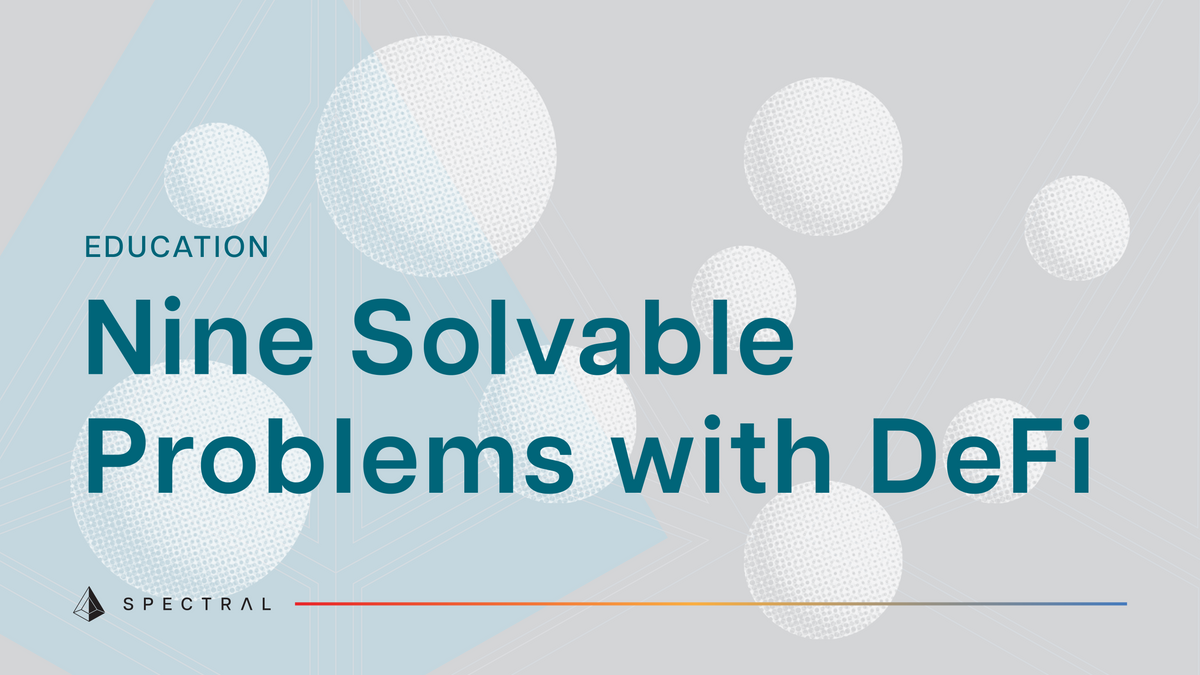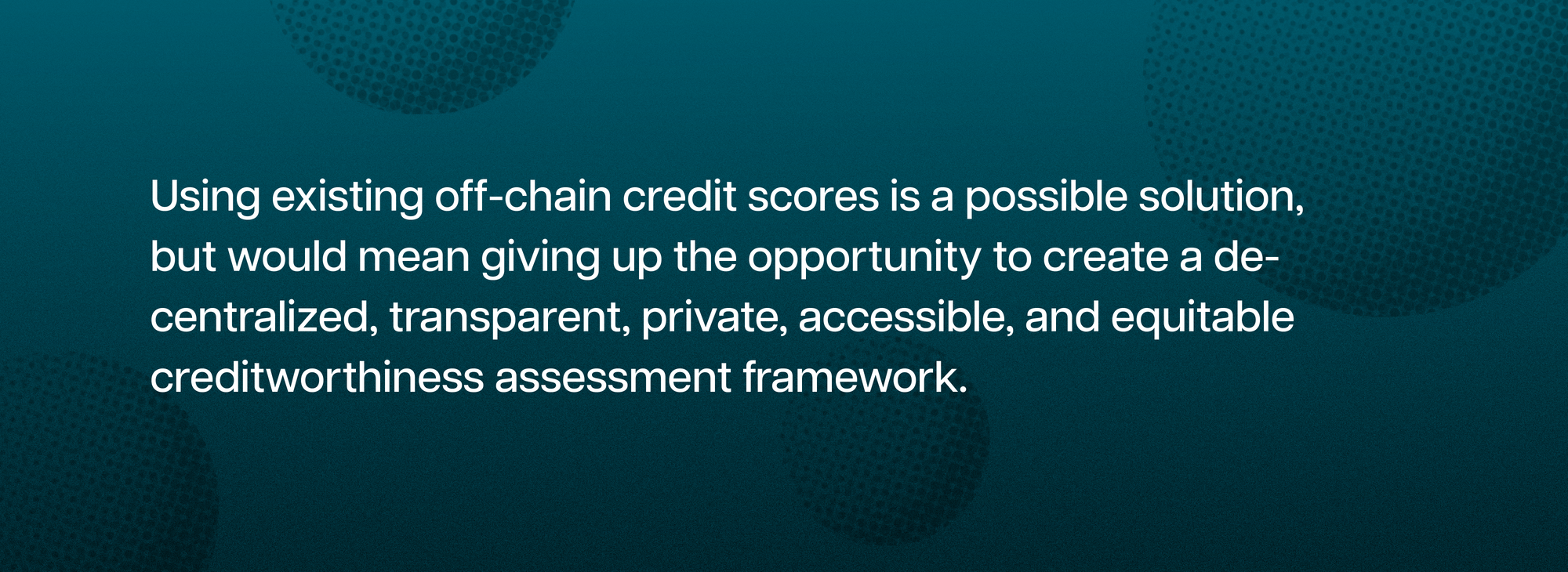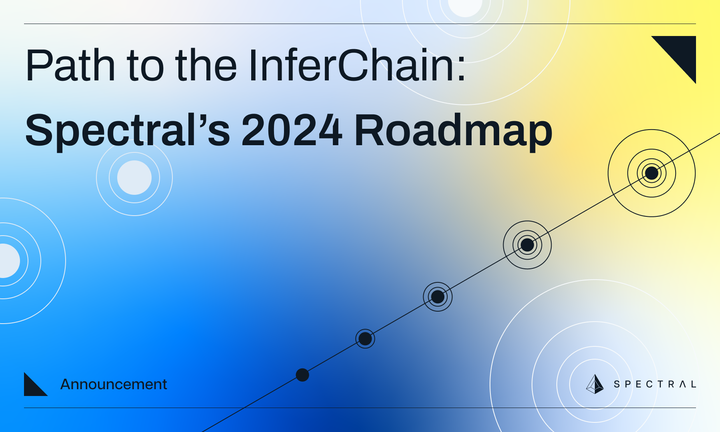Nine Solvable Problems with DeFi
Recent financial turmoil in the cryptocurrency markets has cast a light on some of the problems with DeFi as it exists today: capital inefficiency, inequality, identity, privacy, stablecoins, asset price volatility, terrible UI and a bad reputation.

DeFi summer has passed and the chill of crypto-winter has set in. Here are nine problems with the space that we think can be solved in the short to medium term.
Capital Inefficiency and DeFi
Capital Inefficiency: DeFi Loans Require Overcollateralization
Decentralized Finance (DeFi) grew quickly and lacks many of the supporting industries that traditional finance (TradFi) has. One important omission is having a robust creditworthiness assessment system.
In a trustless environment, it’s difficult to verify who a person is, let alone collect on an unpaid loan.
Rather than building a way of identifying wallets and mitigating risk for lenders, DeFi protocols usually demand overcollateralized loans, i.e. putting aside more capital than borrowed. At best, this is a stopgap solution. It means only borrowers who hold large amounts of capital can borrow from DeFi lending protocols, that loans can’t be priced according to a borrower’s risk of default, and that various forms of unsecured lending such as commercial credit are risky or impossible using DeFi protocols.

Inequality: Incentive systems reward entrenched capital
Overcapitalization in DeFi has other negative effects. Token emissions and incentives based on volume borrowed concentrate capital and ensure that voting rights, even in what appear to be democratic instruments like decentralized autonomous organizations (DAOs), prioritize the interests of existing moneyed lenders and borrowers.
As DeFi expands to unbanked and historically underserved populations, an alternate way of creditworthiness assessment will have to be found.
Using existing credit scores from off-chain providers to mitigate risk and price loans accurately is a possible solution, but would mean giving up the opportunity to create a decentralized, more transparent, more private, accessible, and equitable creditworthiness assessment framework.
By generating credit scores on demand based on on-chain information, using a decentralized network of independent risk modelers such as Spectral Finance’s Scoracle network, DeFi protocols could avoid recreating many of the pitfalls of the traditional credit bureaus.
Read more about How Web3 Creditworthiness can create Financial Inclusion.
Privacy and Portable Identity on Public Blockchains

Identity is Difficult to Prove on a Public Blockchain
Web 2.0 expanded many of the invasive data-gathering practices that grew out of credit intelligence and marketing into our social lives. All of a sudden, companies could triangulate what you’d bought with your occupation and income, and glean highly personal information about your friends, family, hobbies, and political beliefs.
Creditworthiness assessment and, by extension, financial reputation, are crucial for building accessible DeFi. But financial reputation and identity shouldn’t be in the hands of data-collecting oligopolies. By using many of the same tools and techniques used for creating decentralized creditworthiness, a decentralized identity token could be created that would help consumers decide whether or not to release their data.
Read more in our History of Credit, Credit Intelligence, and Credit Scoring
Privacy is Difficult to Preserve on a Public Blockchain
It may seem counterintuitive given the previous entry, but privacy is also a major issue with on-chain transactions. Transactions sitting in a mempool are vulnerable to attacks like frontrunning, where bots scour Ethereum blocks for profitable transactions and then bribe their way into the queue before them to snipe the trades. Transaction tumblers like TornadoCash can obscure the identity of parties transacting on a DeFi application, but additional gas prices and the time and technical complexity to execute these transactions can make them difficult for casual users or small transactions.
A better option being explored involves zero-knowledge proofs, which, combined with “roll-ups” allow multiple transactions to be wound up in a single, public, blockchain transaction.
DeFi can be Difficult and Risky

Stablecoins Can Come Unpegged
Stablecoins are cryptocurrencies that are pegged to the value of various "fiat" currencies, usually the US Dollar. They help smooth the flow of capital from on-chain to off-, and come in various designs. Some are backed one-to-one with currency, some with crypto assets, while others are algorithmically balanced with a second cryptocurrency. The trouble with all stablecoins is that when markets become unstable their values can fluctuate and sometimes the peg can be too difficult to maintain. When that happens (such as TerraUSD’s in 2022), values collapse which can feed into bank runs and market collapses.
One potential solution to stablecoin instability is the creation of Central Bank Digital Currencies (CBDCs) capable of interfacing directly with web3 marketplaces. CBDCs come with their own privacy concerns, however, so many web3 consumers might prefer a consortium-backed stablecoin such as USDC or, once DeFi has grown large enough, doing away with stablecoins entirely. Ultimately, creating a risk assessment infrastructure will help mitigate some of the problems that stablecoins can cause by accurately pricing in risk.
Asset Price Volatility Creates Unique Risks
Rapid fluctuations in the price of cryptocurrencies can cause problems for DeFi users that they would rarely or never encounter in TradFi. One common issue is impermanent loss, which occurs when liquidity providers, who stake two types of coins in exchange for a steady flow of fees from a DeFi protocol like Uniswap, lose money when the price of one of the currencies rises or falls in relation to the other.
There are other problems that occur during trades such as price slippage, which occurs when the price of an asset changes when buying or selling to an exchange with a limited supply. This is another potential use case for risk assessment, allowing users to properly mitigate risk in the trades they’re making.
Read more, with Campbell Harvey's DeFi and the Future of Finance.
DeFi’s (Well Deserved) Bad Reputation
Cryptocurrency remains relatively unregulated and much of DeFi exists beyond borders and jurisdictions. This “wild west” atmosphere attracts legions of scammers, confidence men, well-meaning but deluded business people, and even organized crime, and rogue nation states. There are innocent issues to content with as well: smart contracts can be vulnerable to attack or badly coded, protocols can go out of business, and DAO-run protocols can be vulnerable to flash-loan backed voting blocs.
If DeFi begins demanding proof-of-income, proof-of-humanity, and other tokens, and building them into the smart contracts controlling their decentralized applications (dapps) then much of the chaos and predatory behavior could be minimized.
UX/UI complexity makes DeFi forbidding to newcomers
Perhaps the most vexing problem with DeFi is how difficult it can be for newcomers to wrap their heads around: Accessing dapps usually involves purchasing cryptocurrency through a payment gateway (usually a centralized exchange like Binance or Coinbase), creating a self-custodied wallet, moving the funds to that wallet, and then interfacing with an application that is capable of spiriting away thousands or even millions of dollars worth of currency with a bad keystroke.
Adapting human-centered design principles and building safeguards like timelocks into dapps could create a more welcoming place for newbies and help extend DeFis benefits all over the world.
Read more with Coindesk on Human Centered Design in DeFi.
Most DeFi isn’t decentralized at all

Centralized Exchanges (CEXs) and custodied wallets rely on trust
Only a small fraction of web3 is decentralized. Most users keep their funds on CEXs. This means funds are kept under the care of a third party, and thus dependent on trust. While regulation has been increasing in some countries, and exchanges are often required to collect customer details and provide a measure of security in the way of deposit insurance, historically, deposits on CEXs haven’t fared well. The collapse of the notorious FTX exchange suggests there may be more are unseen dangers still lurking with even the most established CEXs.
Read about a related problem in NFT Safety and Data Science: An Interview with ClubNFT
Help us solve some of the biggest problems in the DeFi space
It’s easy to forget the massive strides made during the past five years of decentralized finance. The apocalyptic warnings about the dangers of proof of work have been left behind as Ethereum, the protocol underlying most DeFi, has shifted from energy-intensive Proof of Work consensus to the much more environmentally friendly Proof of Stake. Help us build what comes next.




